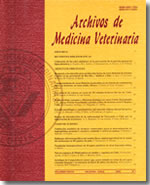Glutathione peroxidase activity in grazing dairy cattle: age and seasonal variations
Main Article Content
Abstract
This study was designed to evaluate the nutritional status of selenium, measuring the blood GSH-Px activity in dairy herds from the South of Chile. Blood heparinized samples were taken from 5 groups (calves, rearing heifers, heifers, dry cows, and early lactating cows) of 7 animals each, from 8 dairy herds in the Province of Valdivia, Chile (39° S y 73° W) in the autumn of 1995. Groups of heifers and early lactating cows from the same herds were sampled during the spring of that same year.
A kinetic method was used to analyse blood GSH-Px activity. The mean and standard deviation of the values obtained were calculated. In order to compare the results among groups and between periods, the Kruskal-Wallis or Mann-Whitney statistical tests were used, as appropriate. The calves presented the highest values for blood GSH-Px activity while rearing heifers and heifers presented the lowest (P<0.01). In the rearing heifer and heifer groups there was an increase in the percentage of animals that presented low values of blood GSH-Px activity (30%). The blood GSH-Px activity of the dry period and early lactation groups was similar (P>0.01). A decrease in the GSH-Px activity was observed in heifers in spring, and the values were lower than those observed in autumn (P<0.01).
These results suggest that there are metabolic imbalances of selenium in dairy herds from the South of Chile; being grazing heifers the most affected.

